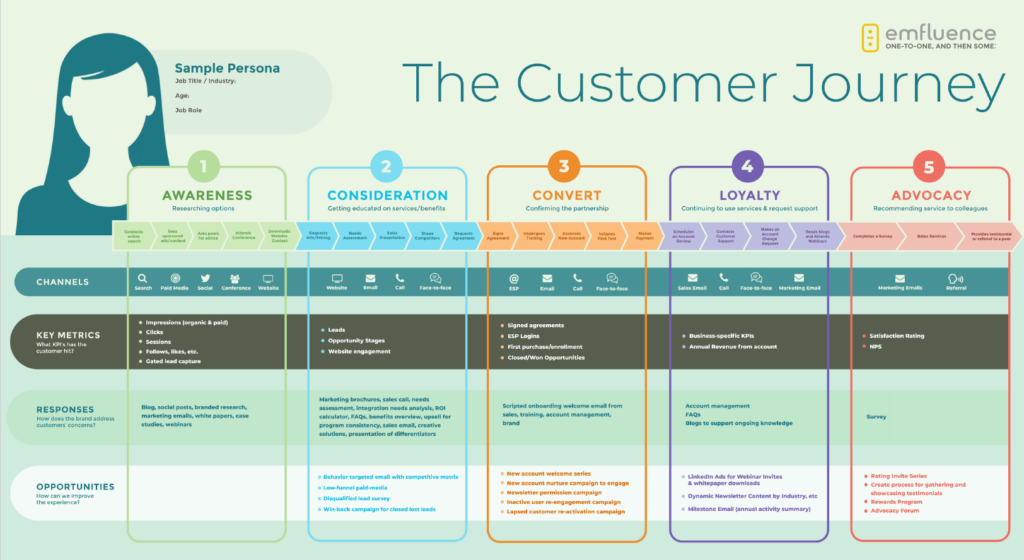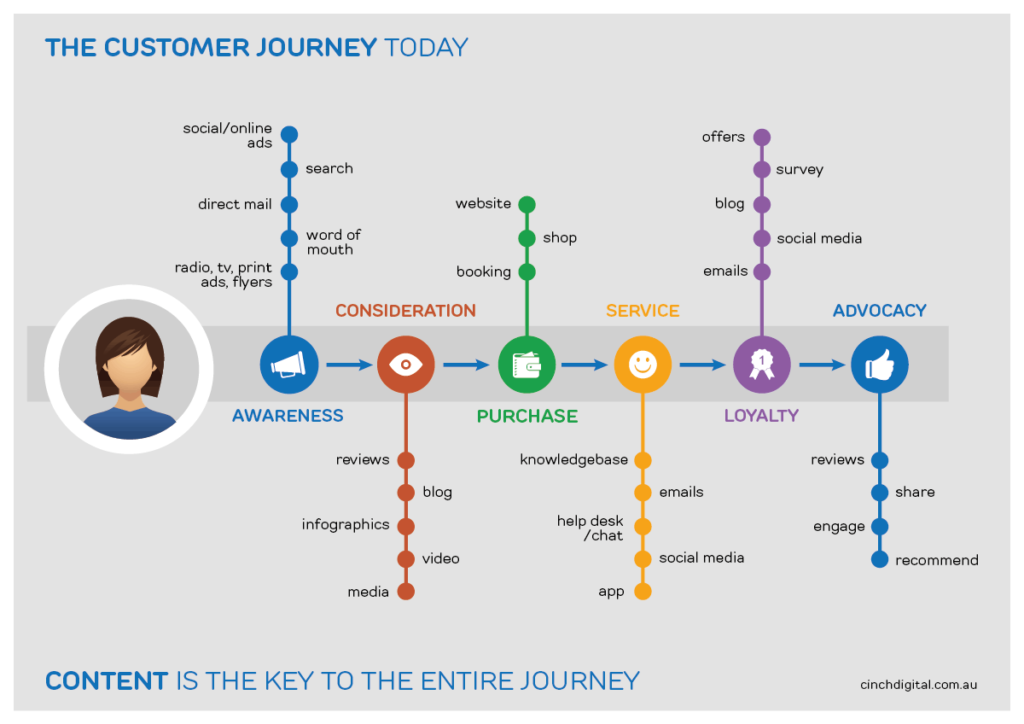Whether you’re a small fashion brand, an event’s planner, or a business owner of any kind, this is for you. If you need marketing within any aspect of your work, listen up. Journey maps help you plan from the beginning, all the way through. Ensuring your companies and your clients needs are met along the way.

What is a consumer journey map?
A consumer or customer journey map, is the route your clients will follow when purchasing your products. This also includes the work you put in before they even consider your products. For example, you know there’s a gap in the market for trainers, so you do your research to see what people want from their shoes. Do they simply want fashion? Is comfort key? What’s hot on the market right now? Are there any trainers that have been overdone? You need to consider the colours you’d show them in, the type of individual you’d market them to and the lifestyle that person would live.
There are so many aspects that go into a product before you can even mock up designs. Otherwise, your products won’t sell because the clients simply aren’t interested. Once you’ve got your products you need to think about, why you? Why should consumers choose you and your company over the thousands out there that offer similar services or items? How can you stand out and what is your USP (unique selling point)? Without all of this information, you can expect your brand to crumble. Everything needs to be covered if you want a chance of selling and making a name for yourself.
So, let’s break down a basic consumer journey map

Awareness
This starts by making your clients aware of your products or brand. How do you do this? Well, it comes down to the advertising and marketing you put out there. They’re likely to find out about new companies through social media. Or, if there’s a particular product they’re looking for, they might search on Google or other search engines. Some consumers take inspiration from radio or physical flyers. It all depends on the type of service you have on offer. For example, something aimed at people 60+ might not perform well advertising on Instagram. However, it might perform well on Facebook, Google or radio.
Likewise, products aimed at teenagers will have to be on social media. Instagram, TikTok, Twitter, absolutely everywhere online you can think of. They spend a large amount of their time on their phones exploring social content, so that’s the best way to target them. They’re far more likely to take inspiration from something they’ve seen on social platforms. Along with this, if you can get the backing or support of an influencer to promote your brand, you are far more likely to see sales from a younger demographic.
Consideration
Once they’ve found your brand, their next move is to see if you’re worth investing in. They’ll head straight to reviews, so you need to make sure they’re good. Sometimes it can be difficult to get reviews because many people only say something if they’re annoyed or experience poor service. However, if everything’s fine with their products, encouraging them to review is slightly tricky. You can’t really offer incentives for their review as often this is seen as bribing. So, it’s really important to let your consumers know just how valued their opinions and feedback are. That way, if they know it will benefit the business and they are happy with the service, they’re more likely to review.
Infographics and media play a huge role in why you’d be considered by a consumer. Photos that are engaging and can attract a potential client’s attention are more likely to help your business sell. Whereas if you have dull and lifeless images showing your brand or product, why would they choose you over your competitors? The same goes for videos. People like to have a mixture of media. Videos capture attention as people scroll through social media or websites because they’re moving around the screen rather than blending in. Without realising the customer will pick up on these things while looking at companies to buy from.
Purchase
This is the part where you’ve caught their attention enough, and they’re going through with their purchase. It might seem like the hard part is done, but that isn’t the case. You need to make sure the process is smooth for them. Consider how you like to buy things. Many people find it annoying to go all through the process of inputting their details and information, just to be hit with a heavy shipping fee they weren’t expecting. If your shipping fee does need to be higher due to your products or services, perhaps mention this earlier on. Otherwise, the customer is not going to have an enjoyable time.
How do they purchase from your site? Or, if you’re an event or service, how do they book you? It’s become popular since social media to allow consumers the option to book via DM (direct message) and from there you can request an email or phone number where they’ll receive confirmation of this booking. The back end side for you is you take their request, view your digital calendar or booking system and then book them in the same way they would themselves. It doesn’t take you very long, but it means a lot to the customer.
Service
What can you offer a consumer? How can you go above and beyond for the customer? After all, the customer is always right. We know that’s not really the case, but in business you need to follow that rule. With that being said, it’s important you put all your focus onto your customer service. How fast will they receive their items? This again is something that isn’t completely within your control. After all, you need to rely on shipping companies. However, you are in charge of the packaging and delivering the goods to the shipping company. That part is on you. So, if you want your consumers to say how quick your turnaround is, make sure you’re on top of things.
Ensure your customer service is impeccable because that’s what people will come down hardest on. If something goes wrong with an order, but the company have been honest and transparent, owning up to their mistakes, and they’re apologetic. Then, the consumer is more likely to look past it and allow them to rectify things. But, if the company aren’t responsive with emails and DMs or come across as rude and uninterested, then why should the consumer recommend them to anyone? They’re far more likely to demand a refund and badmouth you to everyone.
Loyalty
This part is how you get your consumers to come back. When thinking about your consumer journey, this is a key part. It’s great gaining new customers, but how can you build up the loyalty with your current ones to bring them back. Do you perhaps offer discount codes once they have purchased? These can be great because if the consumer likes your products, and they’ve had a good experience buying through you, then they’re more likely to want to buy again. So, a discount code is a win-win. Especially for you if it has an expiry date.
Ask them to fill in a short survey weeks after their order. Then they’ll know how they’re getting on with the product and can review it fairly. They’ll be able to talk about your consumer care, shipping and the ease of ordering through you as a company. All of these things matter to potential clients, and you can use this feedback within your marketing. Don’t forget, sometimes they need a little reminder to fill out their survey. Try putting engaging posts up on social media and getting consumers involved that way. They’ll soon share their experiences within your comments.
Advocacy
The last but not the least bit is all about how the consumer then uses their experiences to shape other people’s opinions. If they’re really appreciative of your service or products, they’re more likely to share your Instagram post. Or, perhaps let their friends and family know about your services. This all comes down to the previous steps though. If they have been followed correctly and your consumer is genuinely happy, you should see some promotion through them. Even if it’s not direct and is through word of mouth only, it doesn’t matter. Providing you get repeat custom and can expand, it doesn’t matter how they hear about you.
If you’re happy with a product or brand, you’re likely to follow their social media accounts to see what’s coming next/You want to say thanks to the company, and you show this through interaction. A few likes and the odd comment might be as far as it goes from the consumer side. However, for a business this is huge. It could be the difference between you making the explore pages or not. A comment or share might lead to other people finding your page and choosing to take a look at your products. You never know where the consumer journey will end.



